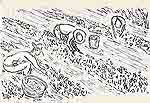
Summer 2005
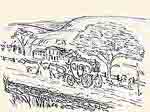

|
|
 |
| Home | Index | Museums | Blog | Authors | Site Map | About |
|
The Jackson Sanitoriumin Dansville, New YorkExcerpts from History of Dansville, 1789 - 1902,
|
| Silica |
0.303 |
| Alumina |
0.023 |
| Iron Bicarbonate |
0.018 |
| Calcium Sulphate |
0.198 |
| Calcium Bicarbonate |
3.704 |
| Magnesium Bicarbonate |
1.137 |
| Sodium Chloride |
0.292 |
| Sodium Nitrate |
0.332 |
| Potassium Nitrate |
0.152 |
|
6.159 |
Its special value therapeutically is due to its alkaline-calcic composition and is particularly adapted to the relief and cure of diseases of the kidney and bladder and also to the carrying away as a solvent all waste material of the tissues of the body, because of its comparative softness and freedom from mineralization, especially the objectionable salts of lime. The water of other springs in and about Dansville is noted for its purity and abundance and even the wells in the old days contained water that was exceptionally good. Now the town is supplied with an admirable water system, giving the best and purest spring water to its inhabitants.
Eminent medical scientists, however, have found a number of other conditions favorable to Dansville as a health resort, in addition to its water supply. The town of Dansville is a natural sanitarium, possessing the following advantages and attractions:
(a) The very best of water in quality and abundant supply.
(b) The soil and sub-soil admits of thorough, even rapid absorption of moisture that might otherwise be in excess. There are no boggy or swampy places within the confines of or adjacent to the town, or in such proximity as to cause dangerous conditions arising from exhalations. Bogs are almost unknown; cases of malarial poisoning are almost unknown. There are no objectionable crops raised, the refuse of which being plowed underground produce exhalations.
(c) The atmospheric conditions are entirely healthful, by reason of the comparative dryness of the climate. Hygrometric observations for a series of years show the conditions at Dansville are such as to cause it to rank in the class of second best according to the United States surveys. Of course it cannot be expected that this region can compete in atmospheric dryness with the high altitudes of the West and Southwest near the Alkali Desert region. Consumption originating here is a rare disease, so is bronchitis and throat difficulty. Dansville is situated on an isothermal line, which accounts for the fact that it is cooler in summer and warmer in winter than adjacent sections of country, cool nights being the rule in hot weather. These facts are marked when comparisons are made with temperatures of surrounding country and are due to the peculiar formation of mountain and valley. Dansville is sheltered so that east and west winds do not reach it, except on rare occasions for a few hours, and the south winds are broken by the southern hills closing the valley in which Dansville lies, being a mile distant from the town. There is probably not quite as much sunshine (many sunny days) as in regions more remote from the lakes, but there can be little to find fault with in this direction. Insect pests, particularly mosquitoes are very few.
(d) Dansville lies about seven hundred feet above sea level and is situated in a valley tributary to the famous Genesee Valley, entering the latter at Mount Morris, fourteen miles to the northwest. This is a region of great scenic beauty: ranges of hills, reaching from twelve to fifteen hundred feet above sea level, surrounding charming valleys; woodland and highly cultivated farms, interspersed with orchards, water-falls in lovely gorges, lakes and far distant views, makeup its scenic attractions.
The drives are unusually delightful and the walks on a whole very good. The village of Dansville has a population of about thirty-five hundred, is charmingly located and has fine streets, dwellings, schools, churches, and opera house, fine golf links and tennis courts, while The Jackson Sanatorium is a special inducement to health seekers. Railroad, telephone and telegraphic connections are the best; it is only eight hours ride from New York City and twenty-four hours from Chicago by through trains.
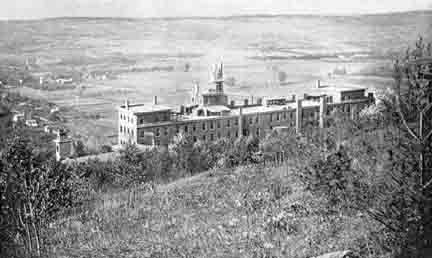
In the past forty years many thousands of persons have sought and found in Dansville health, rest and recreation, and these remember their experiences as pleasant and beneficial.
This institution has been for forty-four years one of the leading features in the life, both business and social, of Dansville. Space does not permit giving in extended form a history of the growth, development and work of this establishment, hence rather a sketchy, or outline, statement of the facts will be attempted.
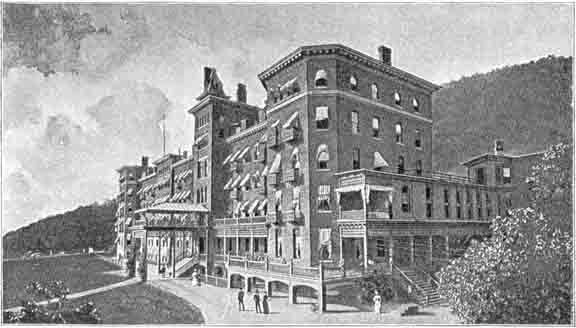
The history of the Institution dates from the year 1852, when Nathaniel Bingham, who was more or less of an invalid and who became interested in the growing Water Cure practice, but lately introduced from Germany, thought it would be a good idea to have a little Water Cure at Dansville. These Institutions were starting up all through the country and were very successful in the cure of chronic diseases and were attracting a great deal of attention, and as they were Water Cures they were founded in proximity to some noted spring. The spring on the east hillside now known as the All-Healing Spring, which burst out one night, years ago, carrying away rocks and trees and earth, and which has been running ever since, was thought to possess curative qualities of value, which was true.
Mr. Bingham associated with himself Mr. Lyman Granger, and the Institution was completed in its first form and ready for occupancy in 1853. Meantime Mr. Bingham's health continued to fail; Mr. Granger thought he would withdraw also from the enterprise so they both sold their interests to Abraham Pennell, at that time a resident of Richmond, Ontario Co., who had a son-in-law (Dr. Stevens) who was anxious to establish in the Water Cure practice. Dr. Stevens opened the Institution but carried it on for only a short time. The building was closed for a year when a Dr. Blackall, a physician of New York City, assumed charge and carried the Cure on for some time. Not succeeding to his desire, he forsook the enterprise and nothing more was done until the year 1858 when Dr. James Caleb Jackson, who had been physician in a similar institution in Glen Haven, Cayuga County, N. Y., and who had been induced by Mr. Pennell to visit Danville and look over the property in the hope that he might, by reason of his extensive acquaintance with water cure people find some one to purchase the same, was so attracted to the character of the spring and the wonderful beauty of the situation and the possibilities for the future, that he entered into an arrangement to lease the property for three years, with the privilege of buying at a stipulated sum within that period.
On the 1st day of October, 1858, Dr. Jackson and his party of helpers, arrived in Dansville and was landed by Captain Henry, who then was the proprietor of the stage line between Wayland and Dansville, at the head of William Street, just at the foot of the hill beneath the Institution, there being no road to the same.
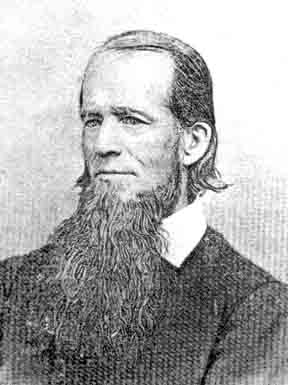
Dr. Jackson was not a man of capital, but a man of ideas and great force of character, and had a large clientage, by reason of his great success as a water cure physician during the time he had practiced at Glen Haven. His eldest son, Giles E. Jackson, his adopted daughter, Dr. Harriet N. Austin, and a good friend, F. Wilson Hurd, who afterwards became a physician, were the original proprietors. As a matter of interest, the capital with which the Institution was started was $750 the partners being equally interested. From this small beginning the institution has grown to its present proportions. The first business organization, established in October, 1848 was known as F. Wilson Hurd & Co. Giles E. Jackson, the eldest son of Dr. James Caleb Jackson, was the business manager. The immediate members of Dr. Jackson's family were: his wife, Lucretia E. Jackson, Giles E., his eldest, and James H. his youngest son.
The institution grew and thrived greatly, so that by the time the winter set in Dr. Jackson had fifty patients under his care, and Dansville was gratified at the success of its Water Cure. Every year saw large additions and betterments in every way, made to the Institution. Liberty Hall was built in 1864, being planned and its construction supervised by Giles E. Jackson. It was built by Alonzo Phillips, a builder of Dansville, as the contractor. The original plot of land upon which the building was erected or connected with the same, was bought of Peter Perine.
The death of Giles E. Jackson of consumption, a disease which he had been fighting for nine years, in June 1864, compelled a dissolution of the partnership, and his mother, Lucretia E. Jackson, and his younger brother, James H. Jackson, inherited his share, and a new co-partnership was made under the firm name of Austin, Hurd & Co., Dr. Austin owning one third, Dr. Hurd one third and Mrs. Lucretia E. and James H. Jackson, owning one-sixth each. The Institution grew and flourished in every way and came to be a power in the town and county and country. Dr. Hurd sold his interest in 1868 to the other partners and the new partnership was entitled Austin, Jackson & Co. Under this title the business was carried on until 1872, when a stock company was organized with a capital of $100,000, of which only eight hundred shares were issued. Meantime something like ten or twelve cottages had been built around the Institution and it had grown to proportions enabling it to accommodate three hundred people and had a national reputation, indeed even at the breaking out of the war, there was represented in it by guests every state and territory of the Union at that time, and in addition Canada and the West Indies.
In 1870 the building on the corner of William and Health streets, originally built by Mr. Henry Brewster and Captain Henry, and used as a hotel and boarding house in connection with Our Home on the Hillside—which was the title of the Water Cure—was bought by Austin, Jackson & Co., and was occupied from that time until January of 1901 by members of the Jackson family.
At the death of Giles E. Jackson, James H. Jackson became the business manager of the Institution. He married in 1864 Miss Katharine Johnson, a daughter of Hon. Emerson Johnson, at that time living in Sturbridge, Mass. Mr. Johnson came to live with his son-in-law in 1866 and was an important factor in the business affairs of the Institution from that time until the date of his death, May 2, 1896. He was a man of sterling character and of large ability and was known all through the country as a very important factor in the business success of the Institution.
On the evening of June 26, 1882, at the high water mark of its success, from a business point of view, and of its reputation as a health resort, the main building of the Institution burned. There was no loss of life but great loss of property on the part of the stockholders and by the guests. The cottages were left, Liberty Hall was left, Dr. James Caleb Jackson at that time had practically retired from personal management of the Institution. He was at that time seventy-one years of age, and in his usual mental vigor but feeble in bodily health, and he had not been for some four or five years very active in the management of the Institution. James. H. Jackson and his wife, Kate J. Jackson, had graduated as physicians in 1876 and 1877 and had been practically at the head of the Institution: Dr. James H. Jackson continued always to be the business manager of it. After the fire, however, a new business combination was made as follows. It was decided to go on with the work on the Hillside, and it was thought that an opportunity existed for one of the finest public health institutions in the world, and Dr. James H. Jackson and Dr. Kate J. Jackson, his wife, with their usual courage, accepted the situation and made a new combination. Dr. Jackson bought in the outside stock until he became the owner of the whole eight hundred shares. He then disposed of thirty shares of the same to his three cousins, Dr. E. D. Leffingwell, Dr. Albert Leffingwell and William E. Leffingwell, these gentlemen being sons of Dr. James Caleb Jackson's only sister Jane E. Leffingwell. They were all well educated and talented men and it was thought that this combination would prove a very strong one, as indeed it did. These gentlemen furnished $20,000 worth of added capital, making the sum total of the issued shares $100,000. $100,000 of cash was borrowed on first mortgage and Dr. James H. Jackson, putting all the property left after the fire and the insurance money and much of his private means into the enterprise, made it possible to build the magnificent, fire-proof main building, which has stood since. It was completed October 1, 1883, as a monument to the enterprise and dauntless energy of its projectors and to the ideas and methods promulgated by the Institution as well as the value of Danville as a Health Resort.
The new building was built by Frederich & Son of Rochester, contractors. The foundations were laid to grade by the Sanatorium organization. It must be understood that at this time the name of the Institution was changed from "Our Home on the Hillside" to "The Sanatorium," Dr. James H. Jackson being the first one in this country to use the word "Sanatorium" as applied to a health institution; a word which has since been recognized as the proper one, rather than the work "Sanitarium," which means a healthful locality or tract of country.
(from History of Dansville, Bunnel and Quick, p. 97) Two statements should be added. For thirty-six years a health magazine entitled "Laws of Life" was edited and sent out by the managers of the institution, through which they made known their philosophy of life, health and disease to many thousands of subscribers in all the states and other countries. Another distinction, shared by Dansville, was the invention by the founder of the twice-cooked food, Granula—the first, and many think the best of the health foods with which the count[r]y is now flooded.
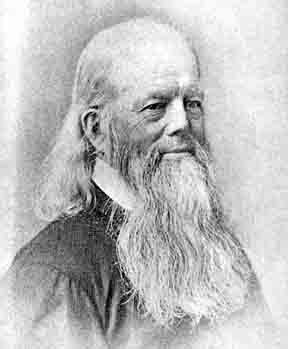
James Caleb Jackson was born at Manlius, Onondaga county, New York, March 28, 1811. He came from patriotic New England lineage. On both sides he was descended from Revolutionary soldiers. His grandfather was Col. Giles Jackson who was chief of staff under Gen. Gates at the Battle of Saratoga and who had the honor of writing out and engrossing the articles of capitulation of Gen. Burgoyne and his army.
The mother of Dr. Jackson was Mary Ann Elderkin, descended from Col. Jedidiah Elderkin of Windham, Conn., a man of more than local renown for his patriotism and military services in the war for American Independence. His name is celebrated in the ballad of "The Flight of the Frogs," familiar to all students of Connecticut history.
Dr. Jackson was the son of Dr. James Jackson, a successful practioner of medicine and surgery in Manlius and the surrounding country. He served also as post surgeon and physician at Sacket Harbor in the war of 1812. It was the desire of Dr. Jackson's father that he should become a physician, but his mother's hope and prayer was that he might go as a missionary to the heathen. Frequently, when alluding to his mother's prayers for him, he maintained that they were answered, although not in the sense she anticipated. He was a studious lad and at the age of twelve years was well advanced in Latin and Greek. His school education was completed at the Polytechnic Institute at Troy, N. Y.
At the age of nineteen he married Lucretia Edgerton Brewster, a lineal descendant of Elder William Brewster, one of the leaders of the colonists who came over to this country in the Mayflower. She was a woman of rare Christian character and in every way worthy of her noble ancestry. The first years of their married life were spent on a farm in Mexico, New York. But the health of the young farmer proved unequal to the demands made upon it. His attention was naturally called to the field of medicine by the necessities of his own case, and thus early he began to read and study medical works at home.
He was a public spirited man and took part in all the local affairs of the community. In this way was cultivated a natural gift for public speaking. While yet in his teens he expoused the temperance cause and frequently spoke at the temperance meetings held in his county and vicinity. The anti-slavery question which had begun to agitate the country interested him greatly and he bacame a prominent speaker in that cause. He was thus brought in contact with Gerrit Smith, through whose influence he entered the lecture field as agent of the New York State Anti-Slavery Society, editor of the Madison Co. Abolitionist, and finally editor and proprietor of the Albany Patriot. In 1846 his health failing, he sold his paper and returned to his home in Peterboro, N. Y., where he had settled in order to be near his friend, Gerrit Smith.
His continued ill health induced him, all other treatment failing, to place himself under the care of Dr. Silas O. Gleason at his institution (water cure) at Cuba, N. Y., in the fall of 1846. The improvement in his own health, and the enthusiasm for the water cure treatment as taught by Priessnitz, the great German medical reformer, led him to form a partnership with Dr. Gleason and open a water cure at Glen Haven, as he called his settlement, situated at the head of Skaneateles lake in Cayuga county N. Y. At the end of three years Dr. Jackson purchased Dr. Gleason's interest and became the proprietor and physiciain of the institution. He took his medical degree from the Medical College in Syracuse, N. Y., and began the career in which he became so renowned and successful. In 1858 he removed to Dansville, N. Y., and on the beautiful wooded "Hillside" looking westward over the picturesque valley and the distant hills encircling it, he founded The Jackson Sanatorium (giving it at that time the name of "Our Home on the Hillside") where his field of work was widely extended. The public opening of the Hillside Home took place on October 1, 1858, and since that time the first of October has been celebrated as Founders Day. Dr. Jackson was always and enthusiastic promoter of these anniversary celebrations, and many old-time members of the Hillside family will never forget some of these festive occasions at which he was the central figure.
The founding and developing of this institution culminated Dr. Jackson's public work. His remarkable powers of mind and spirit were devoted to the work thus inaugurated and were freely spent in the cause of health reform, which to him had become a sacred cause. As physician, as lecturer, as editor of his health journal, "The Laws of Life," he vigorously prosecuted his mission and eloquently preached the gospel of health. In his methods of treatment he was opposed to the prevalent use of drugs. He sought by initiating normal habits of life and conformity to the laws of health to remove the causes of sickness. He placed great value upon mental and moral influences in the cultivation of courage, hope, cheerfulness, in strengthening the will and banishing doubt and despondency, as well as upon prudence in eating, drinking and dressing and in the observance of all physiological laws. He fully believed in the power of the mental and spiritual forces to restore and preserve health, and made these forces constantly available in his professional work. The term "psycho hygiene" which he early applied to his methods of treatment, fitly expresses the idea he so successfully worked out in his practice.
In 1879 Dr, Jackson's failing health obliged him to resign the responsible management of the Sanatorium to his son, Dr. James H. Jackson, although he continued to hold quite active relationship to it until 1883, often counseling with the physicians and lecturing in the chapel of the Sanitorium. From 1886 to 1895 Dr. Jackson lived in North Adams, Massachusetts, with certain members of his family. Here he was free from care and intrusion. He wrote for the Laws of Live and Journal of Health, and kept up a voluminous correspondence with old friends, patients and professional and public men. He was interested in all the great political questions and other movements in the world of thought and trade. He was delegate to the first State convention of the Republican party and a stalwart member of it till the day of his death. He frequently made visits to his old home in Dansville, renewing the scenes of his busy and successful life and cultivating his oldtime friendships. On one of these visits he was taken ill, and after a three weeks' illness died on July 11, 1895, in his eighty-fifth year….
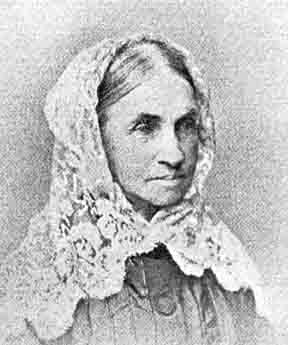
Lucretia Edgerton Jackson was born in the town of Mexico, Oswego Co. N. Y., Feb. 26, 1810, being the daughter of Judge Elias Brewster, an early resident of the town, and a man of force and prominence in the community. She was a direct descendent of Elder William Brewster, sometimes called the Chief of the Pilgrims, and used to pride herself on her good Puritan blood which showed itself in her a worthy descendant of the Elder, in her wonderfully developed character, noted for its quietness, steadfastness, her sunny disposition and Christian graces. In 1830 she married James C. Jackson at that time a resident of Manlius, Onondaga Co., N. Y., and was a helpmeet indeed to him in all his work in the early temperance and anti-slavery days, sheltering at her house in Peterboro, N. Y., ofttimes when her husband was away on his lecturing trips, negroes who were enroute by the underground railway from the South to Canada in the years from 1830 to 1845. When Dr. Jackson became interested in health reform in 1847, making his first venture in this direction as practicing physician in the control of the Glen Haven Water Cure at the head of Skaneateles Lake, Cayuga Co., N. Y., she was foremost in all the affairs of a competent and busy housewife. Coming to Dansville with him in 1858, she was for some eight or ten years active in the management of the culinary and housekeeping departments of Our Home on the Hillside, but eventually yielded this position to her daughter-in-law Katherine J. Jackson. From this time until the day of her death in Feb. 1890, at which time she lacked a few days of being 80 years old, she lived in comparative retirement, for some years at Dr. Jackson's Lake home at Maple Beach, Conesus lake, and the rest of the time at the family residence known at Brightside.…
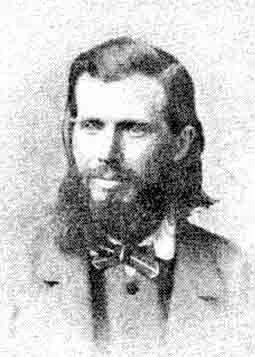
Giles Elderkin Jackson was born in the village of Peterboro, Madison County, N. Y., on June 20, 1836, the eldest son of Dr. James C. Jackson. He moved with the Jackson family to Glen Haven, Cayuga Co., N. Y. at the age of thirteen years, and had his academic education in Homer, Cortland county, N. Y., at an academy in those days famous for the educational opportunities which it offered, presided over as it was by President Woolworth, one of the early Regents of the State. After gaining his education he broke down while accountant for the firm of Miller, Orton & Mulligan a publishing house at Auburn, N. Y., bled at the lungs, and was sent to Nebraska for is health in 1857, where he took up and entered land seven miles back of Omaha and Florence, Neb. At that time Omaha had only a few hundred inhabitants. In the fall of 1858 he came back to Glen Haven very much improved in health, and participated in the emigration of the Jackson family to Dansville and became the active business head of the new partnership of F. Wilson Hurd & Company, and continued so to be until his health again failed. In 1861 he was superseded by his brother Dr. James H. Jackson in the active care and oversight of the business of the Institution. He lived to the age of twenty-nine, dying on the 29th of June, 1864.
He will be remembered by the citizens of Dansville who are familiar with the early history of the Institution, as a man of rare promise, with literary gifts, and a spiritual culture not often attained at so early an age. He originated the idea and made the plan for the building which is now known as the Chapel of the Jackson Sanatorium, in those days called Liberty Hall. This building erected in 1862 - 1863 is today a monument to his forethought in providing a hall, from the platform of which his father might promulgate to the thousands who came to his Institution the philosophy and practices underlying it which were so wonderful in their beneficent effects in reconstructing the health and spiritual life of his patients.

Harriet N. Austin, M. D., was born in Connecticut Aug. 31, 1826. She came to Moravia, Cayuga Co., N. Y., with her family and after finishing her education in the schools of the village graduated in medicine at the college presided over by Dr. R. T. Trall, in New York City. This was the first so-called Hydropathic college grounding its students in all the ordinary branches of medical practice except those of drug giving, teaching a new system of therapeutics modified somewhat, but practically the same as that introduced by Priesnitz, the Bavarian peasant, the so-called discoverer of the water cure or hydropathic treatment of disease.
Soon after her graduation she sought admission to the medical staff of the Glen Haven water cure, at that time presided over by Dr. James C. Jackson, who was afterwards the founder of The Jackson Sanatorium in Dansville, becoming an active practitioner in that institution about the year 1852. Her talent and most excellent work, and her superior character led to her being adopted into the Jackson family, thus becoming a permanent member thereof, so that when Dr. Jackson and his family came to Dansville to open the Institution, at that time known as Our Home on the Hillside, she came also, and became a partner in the first business enterprise and continued to be identified with the same actively and in a business and professional way until the reorganization of the Institution after the fire in 1882, at which time she sold her interest to Dr. James H. Jackson, though she continued to write for the "Laws of Life and Journal of Health," a magazine of which she had been editor for many years, and through which, by her writings, she had large influence on the public in the direction of medical reform, and particularly along the line of reformation in dress for women. She was one of the members of Dr. Jackson's family, who in association with many of the guests and helpers of Hillside, wore the so-called "American costume" for many years, both at home and abroad, and was known as one of the leading dress-reformers of the country, traveling and speaking in favor of the American costume as a dress for women, much more healthful, and in every way better fitted for them for many reasons, than the long skirts and tight waists prescribed by fashion. Her picture at the head of this sketch represents her in her costume, and will doubtless in the minds of many old residents of the town call up association of the early days of the Institution, and incidents in the history of the village.
Miss Austin died at the residence of Dr. Jackson in North Adams, Mass., in May, 1891, and was buried in the Jackson lot in Greenmount cemetery.
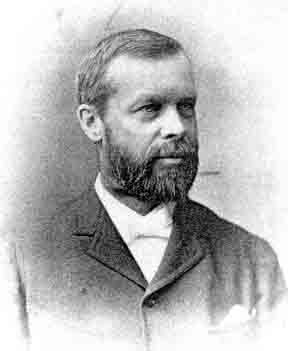
James Hathaway Jackson, the subject of this sketch, has been for forty-four years a citizen of Dansville, and intimately connected with the Jackson Sanatorium, in its foundation, growth and development. His great great great grandfather was Lieutenant John Jackson, an inn keeper of Cambridge, Mass., who inherited the Brattle street lands of his uncle Richard Jackson, and who was active in Cambridge affairs from 1660 to 1690, and a member of Major Appleton's company in the Narragansett war. His great great grandfather was Deacon John Jackson, born in Weston, Mass.; and who was one of the first settlers of Tyrringham, Mass. His great grandfather was Col. Giles Jackson of Monterey, Mass., who was major of the first Berkshire regiment of of the Massachusetts militia, and served in the Revolutionary war, being a member of the staff of General Horatio Gates at the Battle of Saratoga, and had the honor of engrossing the terms of capitulation which General Burgoyne signed upon his surrender to General Gates. His grandfather was James Jackson, physician, surgeon and farmer of Manlius, Onondaga County, New York. He was post surgeon at Sackett Harbor in the war of 1812. His father was Dr. James Caleb Jackson, a sketch of whom will be found in this history. On his mother's side he was a descendant of Elder William Brewster and Gov. William Bradford of the Pilgrim Fathers, his mother being the daughter of Judge Elias Brewster of Mexico, N. Y.
Born and reared until the age of seven years in the town of Peterboro, Madison county, N. Y., he then with his father went to Glen Haven, Cayuga county, where he lived until 1858, being 17 years of age the fall he came to Dansville. He attended school in the old brick schoolhouse under Prof. Seager, and afterwards finished his education at the Dansville seminary under the same teacher. He graduated from Eastman's Commercial college in the spring of 1861, and became the cashier and bookkeeper of is father's institution in the month of May of that year, and the next year became superintendent and general business manager, which office he held without interruption or any interregnum until 1883, when for three years the management passed into the hands of William E. Leffingwell, under the new organization of the Sanatorium. In 1864 he married Katherine Johnson, daughter of Hon. Emerson Johnson of Sturbridge, Mass., who afterwards came to live with his son-in-law. On the death of his brother Giles E. Jackson he became a partner in 1864 in the institution, who business he continued to manage. In 1873 he began his medical studies, graduating in the spring of 1876 from the Bellevue Hospital Medical college of New York City, and at once entered upon a professional career as his father's first assistant on the medical staff of the institution. His father's declining health gave him a leading position on the staff from 1882 onward. In the year 1888 he bought out his partners, the brothers Leffingwell, and became sole owner of the great institution. He, however, at once associated with himself in the ownership and management of the institution Dr. Walter E. Gregory and his wife, Mrs. Helen Davis Gregory. On May 4, 1868, James Arthur Jackson was born, the only son of Dr. James H. and Katherine Jackson, who early became associated with his father in the business of the institution, and was admitted to ownership and to the directorate of it in 1900.
…Dr. Jackson is a member of the Sons of the American Revolution, the Society of Colonial Wars and the Society of Mayflower Descendants.
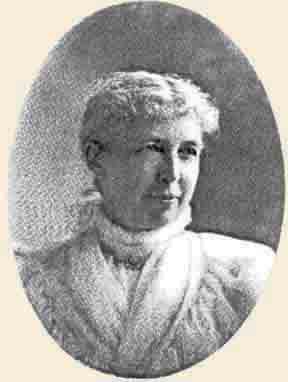
Katherine J. Jackson, M. D., was born in the town of Sturbridge, Massachusetts, April 7, 1841, her father being Hon. Emerson Johnson, a sketch of whom is given in this work. Her great-grandfather was one of the earliest settlers in that town. He was a member of the Massachusetts Militia, joining the Revolutionary Army the day after the battle of Lexington. Her mother was Hannah Arnold, also of the same town.
Mrs. Jackson's education was completed at Hartford, Conn. At the close of her school life she studied stenography and becoming expert, applied for a position as stenographer to Dr. James C. Jackson, at Our Home on the Hillside. Mrs. Jackson's step-mother (Fanny B. Johnson) had been a patient of Dr. Jackson's when he was practicing at Glen Haven, Cayuga county, N. Y., and thus the two families knew something of each other. Her application was accepted, and she came in January 1862 and acted as stenographer to Dr. Jackson, with short interregnum, until September 13, 1864, when she married Dr. James H. Jackson, who was then business manager of Our Home. She filled until 1873 the position of overseeing matron of the institution, going at this time with her husband to pursue a medical course with him. She was an attendant upon the college of the New York Infirmary for women presided over by Dr. Emily Blackwell, one of the earliest Medical Colleges for women in this country, and one of the best. For four years she pursued her studies in medicine, graduating as valedictorian of her class, and returned to enter upon her medical profession as lady physician in the institution, in the spring of 1877. Her identification with the institution as co-worker with the proprietors and members of the faculty has been without break up to the present time, although latterly her duties have been those of Emeritus physician rather than of one in active medical practice, but socially she has been and is still largely identified with the work and interests of the institution. It is fair to say that the welfare of the institution, its popularity with its guests, and the good health of hundreds of women have been due to the conscientious, devoted and tactful work of this lady. All who know her recognize her as one of the leading factors in the growth, development, and present success of The Jackson Sanatorium.
Her professional work has not allowed her to enter into the public or social life of the town very much in all these years, but her public spirit and generosity are well known. She has lived to see her son James Arthur Jackson filling his place as business manager of the institution, and as a busy practicing physician on its staff, successful and honored in his career.
James Arthur Jackson, M.D., only son of Dr. James H. Jackson and Katherine Johnson, was born at Dansville, May 4, 1868. He has always lived in Dansville, receiving his education at the Academy, and the preparatory schools of Cornell University, and a thorough business education at the Rochester Business University. He began early in his life to associate himself with his father in the management of the business of The Jackson Sanatorium; in fact he became associate business manager of the same before he had secured his medical education, and kept sharp watch of its affairs during the period of his passage through the University of Buffalo, from which he graduated as physician in 1895, only a few days after the death of his grandfather, who, had he lived a few days longer, would have been able to say that his son and grandson had been practicing physicians during his own lifetime in the institution which he had founded.
In 1891 he married Ethelwyn McMullen, daughter of George W. McMullen of Picton, Ont., Canada, and to them a son James Arthur Jackson, Jr. was born April 15, 1898.